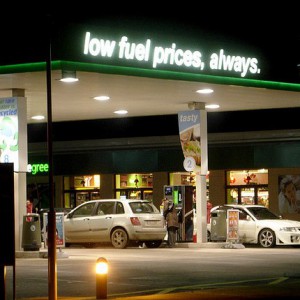
Does The Tax On Petrol And Diesel Need To Be Reviewed?
22 Jul 2015Key Point
This note looks at the effective tax rates on petrol and diesel in Ireland relative to the OECD. A tax differential between the two fuels is examined. This note asks why petrol is taxed more than diesel, and if our taxation of these fuels for road usage needs to reviewed.
Background
The OECD (2015) report on taxing energy use contains the average effective tax rates on energy use across the 34 OECD countries and seven partner economies. The report examines the effective tax rates on petrol and diesel for road use, measured as euro per Gigajoule (GJ) in the OECD 34 countries.
Taxing Gasoline and Diesel
The effective tax rates for gasoline and diesel are shown in table 1 for the OECD 34 countries. The countries are also ranked from highest to lowest respective of the price per Gigajoule (GJ) of fuel for road use.
Table 1
(Source: OECD, Taxing Energy Use 2015)
Taxing Petrol
Ireland has an effective tax rate on gasoline of €18 per GJ, which is 16% above the OECD average (€15.5). Ireland has the thirteenth highest effective tax rate on petrol in the OECD. The three highest tax rates on gasoline are found in Turkey (€25.5), the Netherlands (€22.6) and Norway (€22.5). Ireland’s tax on gasoline for road use is sixteen times higher than that of the United States which is ranked 33rd.
Taxing Diesel
Ireland’s effective tax rate on diesel is €13.3 per GJ. This is 27% above the OECD average of €10.5. Ireland has the eighth highest tax on diesel in the OECD. The three highest effective tax rates are found in the United Kingdom (€19.5), Switzerland (€17.5), and Italy (€16.5). New Zealand has the lowest effective tax rate on diesel in the OECD at €0.1 per GJ.
Tax Differential – Petrol and Diesel
The difference in the effective tax rates for petrol and diesel reflect the energy and environmental policies in place in various countries.
Figure 1 below shows where the largest percentage differentials are found between rates of tax on gasoline and diesel in the OECD. As petrol in New Zealand is taxed more than one-hundred times the tax on diesel, it is not included in the figure below. New Zealand has the largest tax differential on these two fuels in the OECD, followed by Chile. Across the OECD, petrol is taxed on average 55% more than diesel1 . Ireland’s average tax rate on petrol is 35% more than diesel.
Figure 1 – Percentage difference between taxes on petrol and diesel

(Source: OECD, Taxing Energy Use 2015)
The United Kingdom has the third lowest tax differential on petrol and diesel in the OECD. Petrol is taxed at an average effective rate of €21.4, while diesel is taxed at €19.5 (10% differential).
Efficient Taxation Policy
In 2013, the transport sector was responsible for the largest share of energy-related CO2 emissions of any sector of the Irish economy (35% of CO2 emissions)2 . Since 2008 – when taxes on vehicles were changed to reflect the CO2 emissions they emit – Irish consumers have increasingly sought to purchase diesel vehicles, which have lower taxation rates than petrol equivalents. The result of this has been a fall in petrol consumption (1.2 Mtoe consumed in 2013) and a rise in diesel consumption (2.4 Mtoe consumed in 2013). In this respect, the tax system has been effective in encouraging consumers to purchase new low-carbon cars. The Green Paper on energy policy published by the Government in May 2014 notes that a:
“shift from petrol to diesel fuelled vehicles has played a significant role in energy efficiency gains and reduction in CO2 emissions. However, this could potentially have impacts for air quality, as diesel vehicles have higher emissions of air pollutants, fine particulate matter and nitrogen oxides” 3.
Diesel vehicles produce less CO2 emissions but they have higher pollution ratios with regard to particular air pollutants. According to the European Environment Agency (EEA), diesel vehicles maintain market share in the EU, constituting 53% of purchases. The European Commission is considering introducing a new car emissions testing process which would include on-road measurements by 2017. It has been argued that laboratory testing of vehicle emissions does not reflect actual emission levels in real-world conditions4 .
Ireland has one of the highest shares of diesel sales in the EU at 74%5 . The ratio of new petrol to diesel cars in 2007 in Ireland was 72% to 28%. In 2014, the ratio had almost exactly switched to 26% versus 74%. The average specific emissions for new passenger cars in Ireland between 2000 and 2014 are shown in figure 2 below. There has been a significant drop – more than a quarter – in average CO2 emissions of new Irish cars since 2008.
Figure 2 –Average Specific CO2 emissions in new passenger cars in Ireland

(Source: SEAI and European Environment Agency)
During the first six months of 2015, 71% of new private cars licensed were diesel; 55,870 diesel and 21,553 petrol cars. Of these 78,660 new private cars licensed, 97.5% of petrol cars and 94.3% of diesel cars were in the A or B tax brackets for CO2 emissions6 .
Conclusion
A number of questions arise:
- Under the polluter pays principle tax rates on diesel and petrol fuels should be taxed at a rate which is commensurate with the total environmental costs they incur. Do we need to change the effective tax rate on petrol and diesel vehicles?
- Should the carbon tax on vehicles be broadened to account for nitrogen oxide (NOx) emissions7 to account for the cost of such pollutants to the environment?8
- As the fuel efficiency of petrol cars is catching up with that of diesel cars (average emissions gap below 3 g CO2/km), should the tax rates on petrol and diesel be rebalanced?
Notes:
1 As petrol is taxed at such a higher rate (more than 100 times) than diesel in New Zealand relative to the rest of the OECD, it is excluded from the calculation of this average.
2 SEAI (2014) ‘Energy in Transport: 2014 report’,
3 DCENR (2014:p53) ‘Green Paper on Energy Policy in Ireland’,
4 The International Council of Clean Transportation has found that real-world NOx emissions for modern diesel cars are circa seven times higher than the limit required by the Euro 6 regulations.
5 European Environment Agency (2015)
6 CSO 2015 half year vehicle licence statistics
7 NOx comprises two pollutants: nitric oxide (NO) and nitrogen dioxide (NO2).
8 New EU regulations (Euro6) limit the emissions of NOx from diesel cars to 80 mg/km in new passenger cars from 1 January 2015. This is a 56% drop in NOx limits from Euro5 in 2009 for diesel cars.







